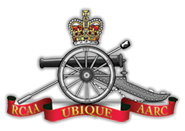Canadianization 1855-1871
The Militia Act of 1855, passed by the Parliament of the United Provinces of Canada, was a milestone in Canadian military history, creating the first truly Canadian army units. The Act provided for the creation of a five thousand-man force which included seven batteries of field artillery and five batteries of foot artillery (batteries organized and trained as infantry with the role of defending the gun positions). Four of these units are still in existence today and are the oldest batteries in The Royal Regiment of Canadian Artillery: the 2nd Field Battery in Ottawa, the 7th Field Battery in Montréal, the 11th Field Battery (Hamilton-Wentworth) in Hamilton and the 57th Batterie de campagne in Levis. The first Canadian regimental-sized artillery unit was formed in 1856 as the Battalion of Montreal Artillery. The unit still exists today as 2nd Field Artillery Regiment, RCA.
The period between 1855 and Confederation was one in which interest in military matters remained high because of the Crimean War, the American Civil War, and the threats, real and imagined, which these posed for Canada. Immediately following the U.S. Civil War, Irish-Americans who had served in the conflict began raiding British North America in an effort to divert British resources from Ireland and, thus, further the cause of Irish independence. These raiders were members of the Fenian Brotherhood.
The Fenians launched several raids into Canada 1866-71. These saw the militia being called out for widespread service, but the role of the artillery was limited in the actual battles that occurred. The most notable engagement fought by the artillery was one in which the Welland Canal Field Battery, acting as infantry, defended Fort Erie against the Fenian force returning from their success in the battle at Ridgeway in 1866. Their gallant stand was doomed from the start, the Gunners being greatly outnumbered, and they were eventually forced to surrender. The last Fenian raid into the new Province of Manitoba in October 1871 resulted in the formation of the oldest militia battery in Western Canada, which still exists today as 13 Field Battery in Portage la Prairie.
After Confederation in 1867, the Dominion Parliament moved quickly to improve Canada’s organization for defence. A Militia Bill, passed in 1868, authorized an Active Militia strength of 40,000 men. Essentially, the terms of the bill extended the militia system then in effect in Ontario and Québec to the two new provinces of Nova Scotia and New Brunswick. By 1870 there were 10 field batteries and 30 garrison batteries.
In 1870, the last British military action in North America saw Colonel Garnet Wolsley lead a mixed force of British regulars and Canadian militia across Northern Ontario to quell a challenge to the sovereignty of the Canadian Government by a provisional government in the Red River Colony. The expedition did not have to fight, and the result was the Province of Manitoba joining Confederation in May 1870. The British troops were withdrawn to England in August, but a Canadian garrison stayed in the two forts along the Red River until 1877. From 1872, this force included the Manitoba Demi-Battery, composed of Regular Gunners drawn from A and B Battery.


